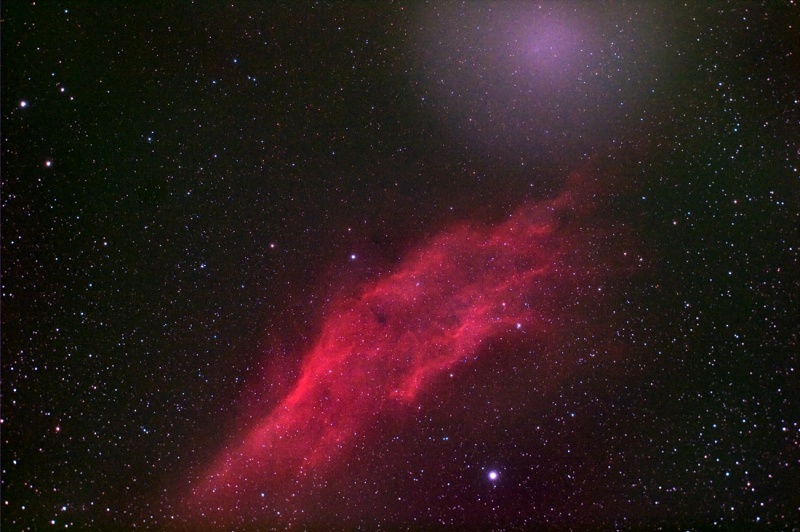
|
Explanation: Still gracing northern skies, a fading Comet Holmes lies at the top edge of this colorful skyview, recorded on March 4. The reddish emission nebula below it is NGC 1499, also known as the California Nebula for its resemblance to the outline of the state on the US west coast. Of course, the two cosmic clouds by chance lie along nearly the same line-of-sight and so only appear to be close together and of similar size. The California Nebula is actually about 100 light-years long and 1,500 light-years away, drifting through the Orion Arm of our spiral Milky Way Galaxy. Comet Holmes is about 20 light-seconds in diameter, sweeping through our solar system a mere 25 light-minutes away, beyond the orbit of Mars. The molecules of the comet's gaseous coma fluoresce in sunlight. The California Nebula's glow is characteristic of hydrogen atoms recombining with long lost electrons, originally stripped away (ionized) by ultraviolet starlight. Providing the energetic starlight is Xi Persei, the prominent star below the nebula.
|
January February March April May June July August September October November December |
| |||||||||||||||||||||||||||||||||||||||||||||||||||||||
NASA Web Site Statements, Warnings, and Disclaimers
NASA Official: Jay Norris. Specific rights apply.
A service of: LHEA at NASA / GSFC
& Michigan Tech. U.
Based on Astronomy Picture
Of the Day
Publications with keywords: comet - emission nebula
Publications with words: comet - emission nebula
See also:
- APOD: 2025 November 17 Á Comet Lemmons Wandering Tail
- APOD: 2025 September 30 Á Comet Lemmon Brightens
- APOD: 2025 September 29 Á Two Camera Comets in One Sky
- APOD: 2025 September 26 Á A SWAN an ATLAS and Mars
- APOD: 2025 September 19 Á The NGC 6914 Complex
- APOD: 2025 September 18 Á Comet C/2025 R2 SWAN
- APOD: 2025 September 16 Á New Comet SWAN25B over Mexico
